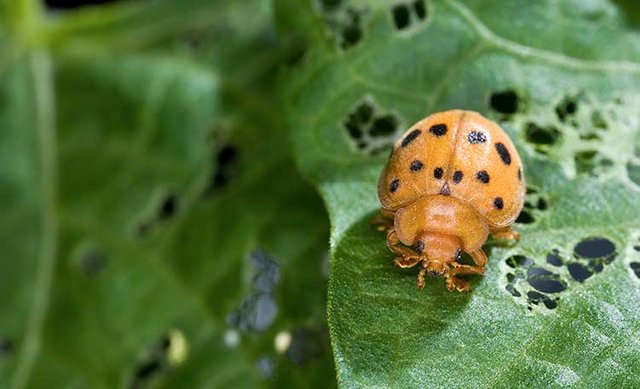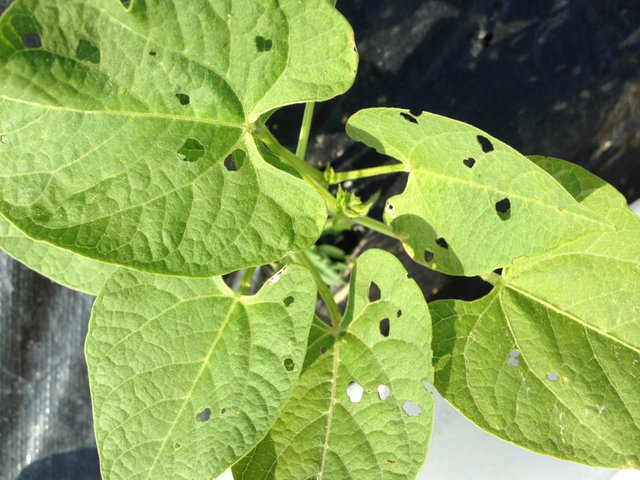Appearance and Life History
The bean leaf creepy crawly can be a damaging vermin of soybean in the Midwest. This scarab is local to North America and was first depicted as a vermin of consumable beans when the mainland was first colonized. As soybean generation expanded, the bean leaf creepy crawly adjusted to sustaining on soybean foliage and units.

Bean leaf bug grown-ups are found in soybean all through a large portion of the season making harm soybean foliage as well as creating cases. They are around 1/4 inch (6 mm) long and generally yellow, tan, or red in shading. The scarab is recognized by an unmistakable dark triangular stamp on its wing covers specifically behind the thorax (the "neck" region of the creepy crawly). Regularly two dark spots are available on each wing spread and a particular dark band reaches out around the external edges. Some of the time the wing covers have no markings, aside from the dark triangle. Whenever aggravated, the bean leaf insect commonly overlap its legs and tumbles to the ground where it might stay unmoving for some time.The bean leaf scarab hatchling is white and particularly sectioned, with a darker head and a dark colored solidified region at the back end of its body. To the exposed eye, it looks relatively indistinguishable to the corn rootworm hatchling. It bolsters on soybean nitrogen settling knobs and, to a lesser degree, soybean roots.
Damage:
An overwhelming bean leaf creepy crawly invasion may cause genuine leaf and unit harm. Overwintering grown-ups colonize early developing soybean, encouraging on the cotyledons, stems, unifoliate leaves, and rising trifoliolates. Stand misfortunes are conceivable in soybean at this phase of development. To begin with and second era bugs bite little round gaps in soybean leaves amid mid and late season. Once the developing foliage turns out to be less appealing to scarabs, they feed on the green tissue of pods, leaving a thin layer over the seed. Amid case development, this layer regularly splits leaving a passage gap for air borne plant pathogens. These pathogens may cause stained, mildew covered, withered, and additionally sick beans.
As noted over, the hatchlings feed on root knobs and support roots. The measure of harm that regularly happens has not been appeared to essentially lessen yields. In this manner, no particular inspecting procedure has been produced to decide larval populace levels.

Sampling Method
There are 3 critical circumstances to assess fields for bean leaf creepy crawly action:
Early in the season it is critical to decide the measure of cotyledon, stem, and foliage sustaining harm caused by the overwintering grown-ups. Since plants are little right now, it's anything but difficult to decide the nearness of insects and their harm. While exploring, decide the level of cotyledon or stem harm as well as the normal rate defoliation level for plants in every one of 5 territories of the field and note the quantity of creepy crawlies per plant. Likewise, note whether the developing point is in effect seriously harmed or murdered on any of the plants. Look for regions where replanting might be essential due to truly harmed or dead plants.
Mid and late season defoliation from first and second era insects must be evaluated to decide if a control application is vital. Decide the rate defoliation level for singular plants in 5 isolate zones of the field and gauge the normal rate defoliation level for the field overall. Survey the scarab populace, and different defoliators, in these same territories to decide their thickness and movement. It is critical to approach the testing territory with alert since the scarabs will drop from the foliage to the ground and stow away with even the slightest bit of plant development. Early in the day (after the dew has dried from the foliage) and early night examining will give a precise photo of the populace since creepy crawlies look for cooler territories, for example, splits in the ground amid the warmth of the day.
Late in the season watch whether creepy crawlies are nourishing on the units. This harm brings about a white paper thin film which covers the seed. Only sometimes does bolstering harm stretch out into the seed. Try not to mistake this for grasshopper harm which for the most part reaches out through the unit to the seeds. Arbitrarily select 2 plants in every one of 5 regions of the field and tally the quantity of units per plant and the number that show bug harm (10 add up to plants). Figure the level of harmed units per plant for the field in general. Note if the cases are green, start to turn yellow, or are yellow/dark colored. Likewise decide the quantity of creepy crawlies per clear utilizing a bug clear net. Take 5 sets of 20 clears in the field. Decide the quantity of bean leaf bugs per clear. Moreover, note whether bugs are still currently sustaining while at the same time looking over the field.
Congratulations @joesph! You have completed the following achievement on Steemit and have been rewarded with new badge(s) :
Click on the badge to view your Board of Honor.
If you no longer want to receive notifications, reply to this comment with the word
STOPTo support your work, I also upvoted your post!
Do not miss the last post from @steemitboard:
SteemitBoard World Cup Contest - Quarter Finals - Day 1
Participate in the SteemitBoard World Cup Contest!
Collect World Cup badges and win free SBD
Support the Gold Sponsors of the contest: @good-karma and @lukestokes
Downvoting a post can decrease pending rewards and make it less visible. Common reasons:
Submit
Congratulations @joesph! You have completed the following achievement on Steemit and have been rewarded with new badge(s) :
Click on the badge to view your Board of Honor.
If you no longer want to receive notifications, reply to this comment with the word
STOPDo not miss the last post from @steemitboard:
SteemitBoard World Cup Contest - Quarter Finals - Day 1
Participate in the SteemitBoard World Cup Contest!
Collect World Cup badges and win free SBD
Support the Gold Sponsors of the contest: @good-karma and @lukestokes
Downvoting a post can decrease pending rewards and make it less visible. Common reasons:
Submit
LETS Have, ReSteem For ReSteem. Resteem My POST, Put Your ID in Comment BELOW, After Confirmation I Will ReSteem Your POST BACK.
My POST Link https://steemit.com/mgsc/@engineermabbas/my-first-ever-post-on-steemit-plz-upvote-and-resteem
Downvoting a post can decrease pending rewards and make it less visible. Common reasons:
Submit